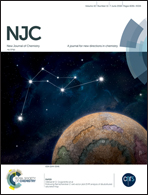Controlled formation of a flower-like CdWO4–BiOCl–Bi2WO6 ternary hybrid photocatalyst with enhanced photocatalytic activity through one-pot hydrothermal reaction
Abstract
In this study, we synthesized a flower-like CdWO4–BiOCl–Bi2WO6 ternary hybrid (CBB) and CdWO4–Bi2WO6 binary composite in the same system using the same raw materials with different molar ratios and compared their photocatalytic activities. The X-ray photoelectron spectroscopy (XPS), X-ray diffraction (XRD) and transmission electron microscopy (TEM) results verify that the transformation of the CdWO4–BiOCl–Bi2WO6 ternary hybrid to the CdWO4–Bi2WO6 binary composite is a topological transformation. Their photocatalytic performances are evaluated by monitoring the degradation of Rhodamine B (RhB). The ternary hybrid (CBB-0.05) shows enhanced photocatalytic activity as compared to pure CdWO4, BiOCl, Bi2WO6, BiOCl–Bi2WO6, CdWO4–Bi2WO6 (CBB-0.10) and the other CBB composites. This remarkable enhancement is attributed to the fact that the suitable conduction band (CB) positions in the ternary hybrid can form a cascade structure and the two layered compounds BiOCl and Bi2WO6 can epitaxially grow from one phase to another with little strain at the interface; this increases the separation efficiency of charge carriers. In addition, the mechanism of the high photocatalytic activity is discussed based on the photoluminescence (PL) spectra and photoelectrochemical and active species trapping measurements.



 Please wait while we load your content...
Please wait while we load your content...